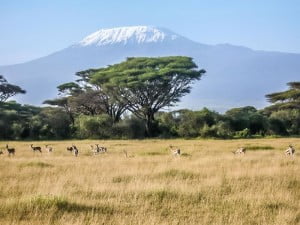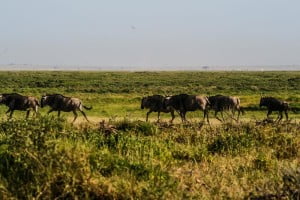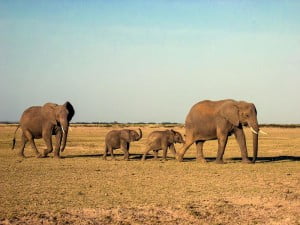Serengeti National Park, located in northern Tanzania, is one of Africa’s most iconic national parks and a top destination for an African safari. Spanning over 14,700 square kilometers, Serengeti is renowned for its annual migration of wildebeest, zebras, and other herbivores, as well as its abundance of predators like lions, cheetahs and hyenas.
Serengeti’s landscapes include sweeping savannas, rivers, kopjes, and woodlands that provide habitat for diverse wildlife species. Notable animals include the Big Five – lions, leopards, elephants, buffalos and rhinos. Over 500 species of birds have also been recorded in the park.
Serengeti National Park is part of a larger UNESCO World Heritage Site ecosystem that connects to the Ngorongoro Conservation Area and other protected areas. This enables wildlife to move freely across different habitats.
For visitors, Serengeti offers incredible African safari experiences like game drives to observe wildlife up close. The best time for game viewing is during the dry season from June to October when animals congregate near water sources. Lodging options in and near Serengeti range from budget campsites to luxury safari lodges.
While wildlife tourism provides economic benefits, the park faces some conservation challenges like poaching and habitat loss. However, Serengeti National Park remains committed to preserving its biodiversity and ecosystems through various research and protection initiatives undertaken in collaboration with partners.
Overall, with its magnificent landscapes, high concentrations of wildlife, and conservation efforts, Serengeti is a top African safari destination that both nature lovers and adventure seekers will appreciate.
ARTICLE SUMMARY
- Serengeti National Park: An African Safari Guide to Tanzania’s Iconic Wilderness
- Key Takeaways
- Geography
- Flora and Fauna
- Conservation Efforts
- Tourism
- History and Culture
- Research and Studies
- Frequently Asked Questions
- What country is Serengeti National Park located in?
- What is the beauty of Serengeti National Park?
- What are the top attractions to see in Serengeti National Park?
- How do I get to Serengeti National Park?
- What is special about Serengeti National Park?
- When is the best time to visit Serengeti National Park?
Serengeti National Park: An African Safari Guide to Tanzania’s Iconic Wilderness
Serengeti National Park is a vast and magnificent park in northern Tanzania, spanning over 14,763 square kilometers. It is home to a diverse range of wildlife, including over 1,500,000 hectares of virgin savanna, and is a UNESCO World Heritage Site. The park’s size and location make it a significant attraction for wildlife enthusiasts from around the world.
The Serengeti ecosystem is defined by the area covered by the annual migration, and the park is contiguous with Ngorongoro Conservation Unit, an area of 528,000 hectares declared a World Heritage Site in 1979. The park’s eastern portion extends 100 miles south from the Kenya-Tanzania border, and it is along the “western corridor” to Lake Victoria that many of the park’s animals migrate. The park’s elevations range from 3,020 to 6,070 feet, making it an excellent destination for hiking and trekking enthusiasts.
Key Takeaways
- Serengeti National Park is a vast and magnificent park in northern Tanzania, spanning over 14,763 square kilometers.
- The park is home to a diverse range of wildlife, including over 1,500,000 hectares of virgin savanna, and is a UNESCO World Heritage Site.
- The park’s size and location make it a significant attraction for wildlife enthusiasts from around the world.
Geography
Serengeti National Park is located in eastern Mara Region and northeastern Simiyu Region of Tanzania. The park covers an area of over 1,500,000 hectares (3,700,000 acres) of virgin savanna. The entire Serengeti ecosystem, covering an area of about 30,000 sq. km., encompasses the Serengeti National Park, the Ngorongoro Conservation Area, the Maswa Reserve, the Grumeti Reserve, the Ikorongo and the Loliondo Game Controlled Areas.
Landforms
The park is situated on a plateau with an elevation ranging from 920 to 1,850 meters above sea level. The park’s western corridor stretches from the shores of Lake Victoria to the Kenya-Tanzania border. The park is known for its vast, undulating plains, dotted with rocky outcrops (kopjes), rivers, woodlands, and acacia savannahs. The kopjes are a unique feature of the Serengeti landscape and provide shelter and vantage points for a variety of animals.
Climate
The Serengeti has a tropical savanna climate with distinct wet and dry seasons. The wet season runs from November to May, while the dry season is from June to October. The average annual rainfall is between 500 to 1,000 mm (20 to 40 inches), with most of the rainfall occurring during the wet season. The temperature in the park remains relatively constant throughout the year, with average temperatures ranging from 15 to 25 °C (59 to 77 °F). The park experiences occasional droughts, which can lead to a reduction in the number of animals in the park.
Overall, Serengeti National Park’s unique geography plays a vital role in supporting the diverse ecosystem found within its borders. From the vast plains to the rocky outcrops, the park’s landscape provides a range of habitats for the park’s many species. The climate of the park also plays a significant role in shaping the ecosystem, with the wet and dry seasons influencing the movements and behavior of the park’s animals.
Flora and Fauna
Serengeti National Park is a world-renowned destination for wildlife lovers. The park is home to an incredible array of wildlife species, including the Big Five (lion, leopard, elephant, rhinoceros, and buffalo) and over 500 bird species [1]. In addition to its diverse wildlife, the park is also home to a variety of plant species, from towering trees to delicate wildflowers.
Plant Life
The Serengeti ecosystem comprises various habitats, including large tracts of plains, woodlands, and riverine forests. These habitats support many species of trees and grasses. Some of the notable plant species found in the park include:
- Acacia trees: These are the most common trees in the Serengeti. They are well adapted to the dry conditions and provide food and shelter to many animals, including giraffes and elephants.
- Baobab trees: These iconic trees are found in the southern part of the park. They can grow up to 30 meters tall and provide food and shelter to many animals.
- Grasses: The Serengeti is home to various grass species, including red oat grass and love grass. These grasses are an important food source for many herbivores.
Wildlife
The Serengeti is famed for its annual wildebeest migration, when millions of animals cross the open plains in search of fresh grazing [2]. The park is home to many other wildlife species, including:
- Lions: The Serengeti is home to a large population of lions. Visitors to the park have a good chance of spotting these majestic animals.
- Elephants: The park is home to a large population of elephants. These intelligent animals are often seen in large family groups.
- Cheetahs: The Serengeti is one of the best places in Africa to see cheetahs. These fast cats are often seen hunting on the open plains.
- Giraffes: These tall animals are a common sight in the Serengeti. They are well adapted to the dry conditions and can go for long periods without water.
Overall, the Serengeti is a must-visit destination for anyone interested in wildlife and nature. With its incredible array of plant and animal species, it is a true natural wonder.
Sources
- [1] Serengeti National Park | Location, Facts, & Animals | Britannica
- [2] Serengeti Animals – Wildlife in Serengeti National Park – SafariBookings
Conservation Efforts
Serengeti National Park is a UNESCO World Heritage Site that is home to some of the world’s most iconic wildlife. The park is also an important conservation area, with a variety of initiatives in place to protect the natural environment and the animals that call it home.
One of the most significant conservation efforts in Serengeti National Park is the involvement of the local community. The park works closely with the Maasai people, who have been living in the area for centuries, to promote sustainable environmental management and wildlife conservation. The Maasai have established nurseries to grow trees and promote reforestation, and they also work to prevent illegal hunting and poaching.
In addition to community involvement, the park also has a number of conservation programs in place to protect the wildlife that lives within its borders. For example, the Serengeti Lion Project is a long-term research initiative that aims to understand the behavior and ecology of lions in the park. The project has helped to identify threats to lion populations, such as habitat loss and human-wildlife conflict, and has provided valuable information for conservation efforts.
Another important conservation effort in Serengeti National Park is the management of the park’s water resources. The park has a number of rivers and wetlands that are critical habitats for a variety of wildlife, and the park works to ensure that these resources are protected and managed sustainably. This includes efforts to prevent pollution and overuse of water resources, as well as initiatives to promote the restoration of degraded habitats.
Overall, the conservation efforts in Serengeti National Park are crucial for protecting the park’s unique wildlife and natural environment. By working with the local community and implementing sustainable management practices, the park is able to preserve this important ecosystem for future generations to enjoy.
Tourism
Serengeti National Park is a popular tourist destination that attracts visitors from around the world. The park is renowned for its vast savannahs, diverse wildlife, and stunning natural beauty. Visitors to the park can enjoy a wide range of activities, including safari tours, camping, hiking, and hot air balloon rides.
Safari Tours
One of the most popular activities in Serengeti National Park is a safari tour. Safari tours offer visitors the opportunity to see the park’s diverse wildlife up close, including lions, elephants, giraffes, zebras, and more. There are a variety of safari tours available, ranging from half-day excursions to multi-day expeditions.
Visitors can choose between guided tours or self-drive options, depending on their preferences. Guided tours provide visitors with an experienced guide who can provide insight into the park’s wildlife and ecology. Self-drive tours offer visitors the freedom to explore the park at their own pace.
Best Time to Visit
The best time to visit Serengeti National Park depends on what visitors want to see and do. The park is open year-round, but the best time to see the park’s wildlife is during the dry season, which runs from June to October. During this time, the park’s animals congregate around watering holes, making them easier to spot.
The wet season, which runs from November to May, is also a good time to visit the park. During this time, the park is lush and green, and visitors can see a variety of migratory birds. However, the wet season can make some parts of the park inaccessible due to flooding.
Overall, Serengeti National Park is a must-visit destination for anyone interested in wildlife and natural beauty. With a wide range of activities and attractions, visitors are sure to have an unforgettable experience in this stunning park.
History and Culture
Serengeti National Park is located in the north of Tanzania and is regarded as the best wildlife reserve in Africa. The park has been listed by UNESCO as one of the World Heritage Sites. The Maasai people have lived in the area for centuries and their culture is intertwined with the park’s history.
The park was established in 1951 and covers 5,700 square miles (14,763 square km) of some of the best grassland range in Africa, as well as extensive acacia woodland savanna. The park was initially created to protect the wildlife populations that were threatened by hunting and poaching.
Over the years, the park has faced many challenges, including habitat destruction, poaching, and conflicts between humans and wildlife. However, the park’s management has implemented many measures to address these issues, including anti-poaching patrols, community outreach programs, and sustainable tourism initiatives.
The Maasai people, who have lived in the area for centuries, have a deep connection to the land and the wildlife. They have a rich cultural heritage that includes traditional dances, songs, and ceremonies. The Maasai are also known for their distinctive dress, which includes bright red shukas (cloths) and beaded jewelry.
Today, the park is one of the most popular tourist destinations in Africa, attracting visitors from around the world who come to witness the annual wildebeest migration and to see the park’s incredible wildlife, including lions, elephants, giraffes, and more. The park’s management continues to work to protect the park’s natural and cultural heritage for future generations to enjoy.
Research and Studies
Serengeti National Park is a unique ecosystem that has attracted researchers and scientists from all over the world. The park’s diverse flora and fauna, including the annual wildebeest migration, have been the subject of numerous studies and research projects.
One of the most significant research projects conducted in the park was the Serengeti Lion Project. The project was initiated in the 1960s to study the behavior and ecology of lions in the park. The project has been ongoing for over 50 years and has provided valuable insights into the social structure, hunting behavior, and population dynamics of lions in the park. The project has also helped to inform conservation policies and management strategies for the park.
Another notable research project conducted in the park was the Serengeti Ecosystem Research and Monitoring Program (SERengeti). The program was launched in 2011 and is a collaboration between the Tanzania Wildlife Research Institute, Frankfurt Zoological Society, and other partners. The program’s goal is to monitor and study the park’s ecosystem to better understand its dynamics and inform conservation policies. The program has focused on a range of topics, including fire ecology, herbivore ecology, and predator-prey interactions.
In addition to these long-term research projects, numerous studies have been conducted on specific aspects of the park’s ecology and wildlife. For example, a study published in the Proceedings of the National Academy of Sciences analyzed two decades of changes in land cover and wildebeest populations in the Serengeti-Mara region. The study found that rainfall and human population growth were the primary drivers of changes in the ecosystem.
Overall, the research and studies conducted in Serengeti National Park have provided valuable insights into the park’s ecology and wildlife. These studies have helped to inform conservation policies and management strategies for the park, ensuring that it remains a unique and biodiverse ecosystem for generations to come.
Frequently Asked Questions
What country is Serengeti National Park located in?
Serengeti National Park is located in Tanzania, East Africa. It is part of the Serengeti ecosystem, which extends into neighboring Kenya.
What is the beauty of Serengeti National Park?
Serengeti National Park is known for its stunning natural beauty, which includes vast grasslands, rolling hills, and rocky outcroppings. The park is home to a diverse range of wildlife, including lions, elephants, giraffes, zebras, and wildebeests. Visitors can also witness the Great Migration, where millions of wildebeests and other animals move across the park in search of food and water.
What are the top attractions to see in Serengeti National Park?
The top attractions in Serengeti National Park include:
- The Great Migration
- The Seronera Valley
- The Ngorongoro Crater
- The Grumeti River
- The Moru Kopjes
How do I get to Serengeti National Park?
The most common way to get to Serengeti National Park is by flying into one of the nearby airports, such as Kilimanjaro International Airport or Arusha Airport. From there, visitors can take a domestic flight or drive to the park. It is also possible to take a guided tour or safari, which will include transportation to and from the park.
What is special about Serengeti National Park?
Serengeti National Park is one of the oldest and most iconic game reserves in Tanzania. It is home to a diverse range of wildlife and is known for its stunning natural beauty. The park is also a UNESCO World Heritage Site and is dedicated to preserving the Serengeti ecosystem for future generations.
When is the best time to visit Serengeti National Park?
The best time to visit Serengeti National Park depends on what you want to see. The dry season, from June to October, is the best time to witness the Great Migration. The wet season, from November to May, is the best time to see newborn animals and lush green landscapes. However, the park can be visited year-round and each season has its own unique attractions.
African Safaris with this Destination

6 DAYS: ARUSHA/ SERENGETI/NGORONGORO/TARANGIRE
06 DAYS: ARUSHA/ SERENGETI/NGORONGORO/TARANGIRE Full Board Tour Guide 4×4 Truck Flexible Date Overview itinerary Information Map Overview itinerary DAY 01: ARUSHAArrival at Kilimanjaro International Airport,

7 DAYS: ARUSHA/MANYARA/SERENGETI/NGORONGORO
07 DAYS: ARUSHA/MANYARA/SERENGETI/NGORONGORO Full Board Tour Guide 4×4 Truck Flexible Date Overview itinerary Information Map Overview itinerary DAY 01: ARUSHAArrival at Kilimanjaro International Airport, go

9 DAYS: NAIROBI/LAIKIPIA/NAIVASHA/MARA
09 DAYS: NAIROBI/LAIKIPIA/NAIVASHA/MARA Full Board Tour Guide 4×4 Truck Flexible Date Overview itinerary Information Map Overview itinerary DAY 01: NAIROBI Arrival at Jomo Kenyatta International
